SUBARU IMPREZA WRX 2004 2.G Workshop Manual
Manufacturer: SUBARU, Model Year: 2004, Model line: IMPREZA WRX, Model: SUBARU IMPREZA WRX 2004 2.GPages: 491, PDF Size: 5.93 MB
Page 51 of 491
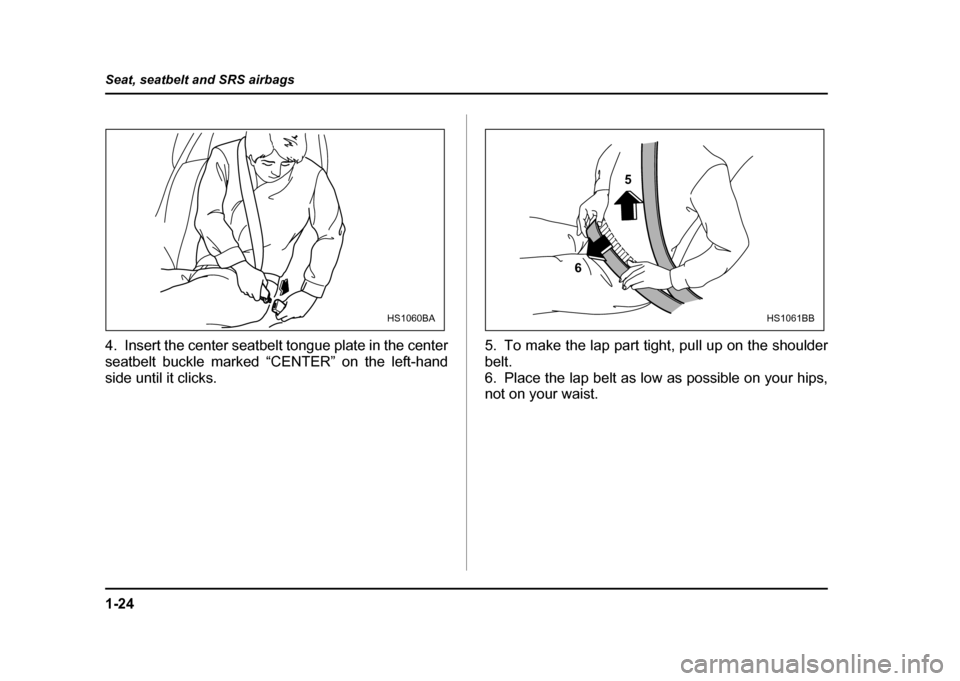
1-24
Seat, seatbelt and SRS airbags
4. Insert the center seatbelt tongue plate in the center
seatbelt buckle marked “CENTER” on the left-hand
side until it clicks.
5. To make the lap part tight, pull up on the shoulder
belt.
6. Place the lap belt as low as possible on your hips,
not on your waist.
HS1060BA
5
6
HS1061BB
Page 52 of 491
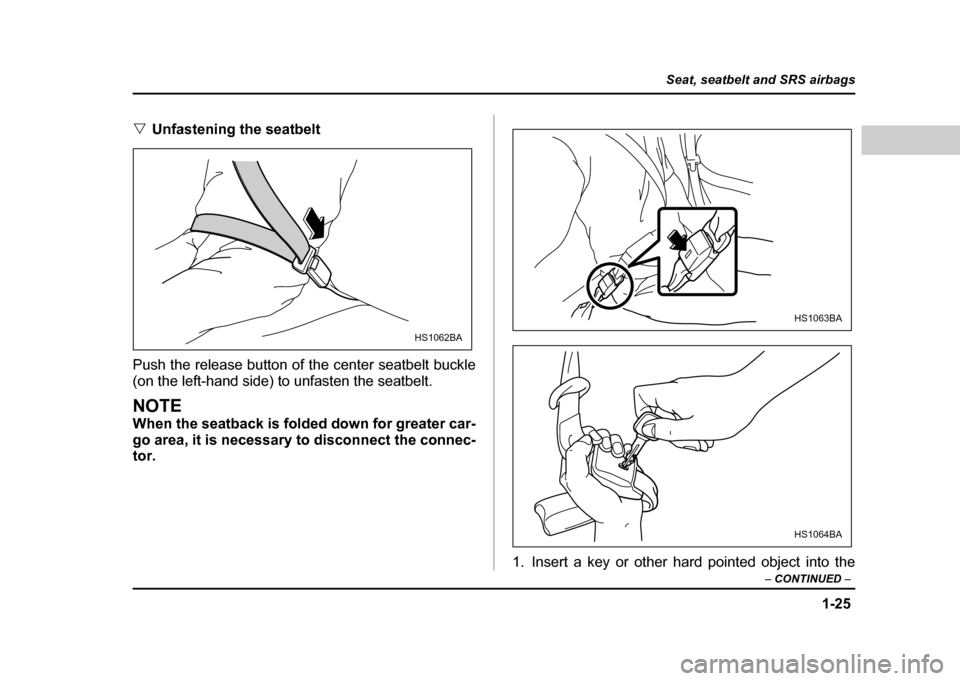
1-25
Seat, seatbelt and SRS airbags
– CONTINUED –
"Unfastening the seatbelt
Push the release button of the center seatbelt buckle
(on the left-hand side) to unfasten the seatbelt.
NOTE
When the seatback is folded down for greater car-
go area, it is necessary to disconnect the connec- tor. 1. Insert a key or other hard pointed object into the
HS1062BA
HS1063BA
HS1064BA
Page 53 of 491

1-26
Seat, seatbelt and SRS airbags
slot in the connector (buckle) on the right-hand side
and push it in, and the connector (tongue) plate will
disconnect from the buckle.
2. Allow the retractor to roll up the belt. You should
hold the webbing end and guide it back into the retrac-
tor while it is rolling up. Insert the tongue plate into the
belt holder.
"
Do not allow the retractor to roll up the seat-
belt too quickly. Otherwise, the metal tongue
plates may hit against the trim, resulting in
damaged trim." Have the seatbelt fully rolled up so that the
tongue plates are neatly stored. A hanging
tongue plate can swing and hit against the trim
during driving, causing damage to the trim.
UG1509BA
UG1510BA
Page 54 of 491
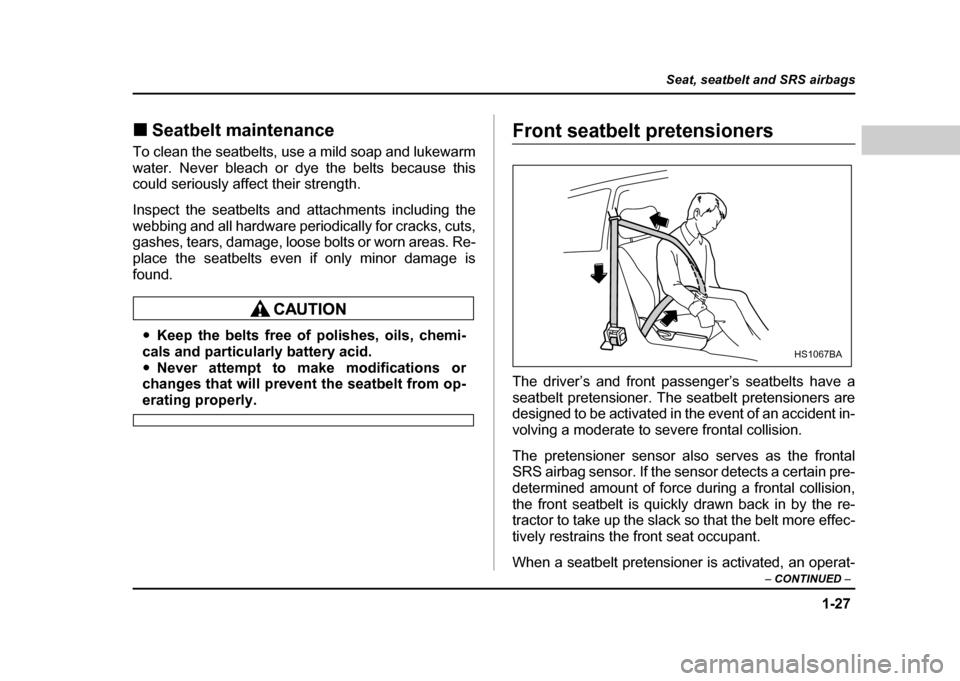
1-27
Seat, seatbelt and SRS airbags
– CONTINUED –
!Seatbelt maintenance
To clean the seatbelts, use a mild soap and lukewarm
water. Never bleach or dye the belts because this
could seriously affect their strength.
Inspect the seatbelts and attachments including the
webbing and all hardware periodically for cracks, cuts,
gashes, tears, damage, loose bolts or worn areas. Re-
place the seatbelts even if only minor damage is
found.
" Keep the belts free of polishes, oils, chemi-
cals and particularly battery acid. " Never attempt to make modifications or
changes that will prevent the seatbelt from op-
erating properly.
Front seatbelt pretensioners
The driver’s and front passenger’s seatbelts have a
seatbelt pretensioner. The seatbelt pretensioners are
designed to be activated in the event of an accident in-
volving a moderate to severe frontal collision.
The pretensioner sensor also serves as the frontal
SRS airbag sensor. If the sensor detects a certain pre-
determined amount of force during a frontal collision,
the front seatbelt is quickly drawn back in by the re-
tractor to take up the slack so that the belt more effec-
tively restrains the front seat occupant.
When a seatbelt pretensioner is activated, an operat-
HS1067BA
Page 55 of 491
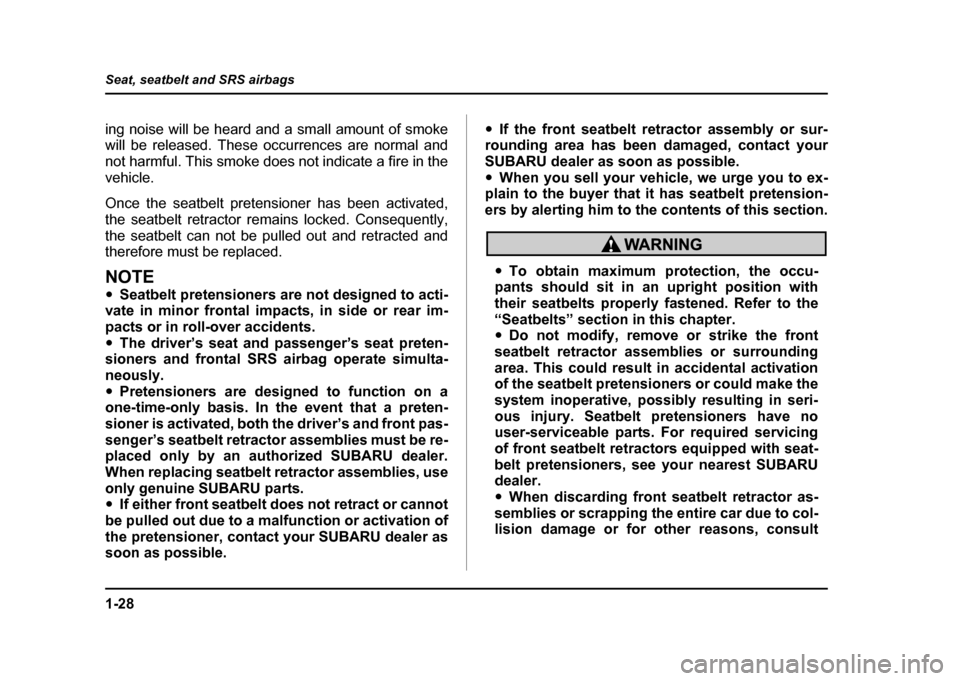
1-28
Seat, seatbelt and SRS airbags
ing noise will be heard and a small amount of smoke
will be released. These occurrences are normal and
not harmful. This smoke does not indicate a fire in the
vehicle.
Once the seatbelt pretensioner has been activated,
the seatbelt retractor remains locked. Consequently,
the seatbelt can not be pulled out and retracted and
therefore must be replaced.
NOTE "
Seatbelt pretensioners are not designed to acti-
vate in minor frontal impacts, in side or rear im-
pacts or in roll-over accidents. " The driver’s seat and passenger’s seat preten-
sioners and frontal SRS airbag operate simulta-
neously." Pretensioners are designed to function on a
one-time-only basis. In the event that a preten-
sioner is activated, both the driver’s and front pas-
senger’s seatbelt retractor assemblies must be re-
placed only by an authorized SUBARU dealer.
When replacing seatbelt retractor assemblies, use
only genuine SUBARU parts. " If either front seatbelt does not retract or cannot
be pulled out due to a malfunction or activation of
the pretensioner, contact your SUBARU dealer as
soon as possible. "
If the front seatbelt retractor assembly or sur-
rounding area has been damaged, contact your
SUBARU dealer as soon as possible." When you sell your vehicle, we urge you to ex-
plain to the buyer that it has seatbelt pretension-
ers by alerting him to the contents of this section." To obtain maximum protection, the occu-
pants should sit in an upright position with
their seatbelts properly fastened. Refer to the
“Seatbelts” section in this chapter. " Do not modify, remove or strike the front
seatbelt retractor assemblies or surrounding
area. This could result in accidental activation
of the seatbelt pretensioners or could make the
system inoperative, possibly resulting in seri-
ous injury. Seatbelt pretensioners have no
user-serviceable parts. For required servicing
of front seatbelt retractors equipped with seat-
belt pretensioners, see your nearest SUBARU
dealer. " When discarding front seatbelt retractor as-
semblies or scrapping the entire car due to col-
lision damage or for other reasons, consult
Page 56 of 491
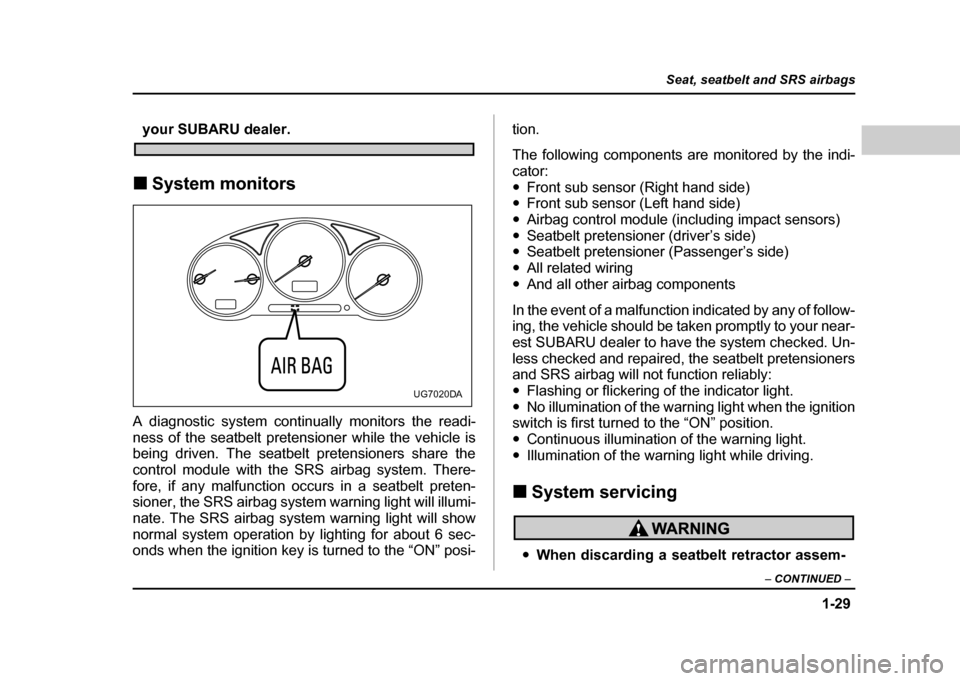
1-29
Seat, seatbelt and SRS airbags
– CONTINUED –
your SUBARU dealer.
! System monitors
A diagnostic system continually monitors the readi-
ness of the seatbelt pretensioner while the vehicle is
being driven. The seatbelt pretensioners share the
control module with the SRS airbag system. There-
fore, if any malfunction occurs in a seatbelt preten-
sioner, the SRS airbag system warning light will illumi-
nate. The SRS airbag system warning light will show
normal system operation by lighting for about 6 sec-
onds when the ignition key is turned to the “ON” posi- tion.
The following components are monitored by the indi- cator:"
Front sub sensor (Right hand side)
" Front sub sensor (Left hand side)
" Airbag control module (including impact sensors)
" Seatbelt pretensioner (driver’s side)
" Seatbelt pretensioner (Passenger’s side)
" All related wiring
" And all other airbag components
In the event of a malfunction indicated by any of follow-
ing, the vehicle should be taken promptly to your near-
est SUBARU dealer to have the system checked. Un-
less checked and repaired, the seatbelt pretensioners
and SRS airbag will not function reliably: " Flashing or flickering of the indicator light.
" No illumination of the warning light when the ignition
switch is first turned to the “ON” position." Continuous illumination of the warning light.
" Illumination of the warning light while driving.
! System servicing
"When discarding a seatbelt retractor assem-
UG7020DA
Page 57 of 491

1-30
Seat, seatbelt and SRS airbags
bly or scrapping the entire car damaged by a
collision, consult your SUBARU dealer. "
Tampering with or disconnecting the sys-
tem’s wiring could result in accidental activa-
tion of the seatbelt pretensioner and/or SRS air-
bag or could make the system inoperative,
which may result in serious injury. The wiring
harnesses of the seatbelt pretensioner and SRS
airbag systems are covered with yellow insula-
tion and the connectors of the system are yel-
low for easy identification. Do not use electrical
test equipment on any circuit related to the
seatbelt pretensioner and SRS airbag systems.
For required servicing of the seatbelt preten-
sioner, see your nearest SUBARU dealer.
The front sub sensors are located in both front
fenders and the SRS airbag control module in-
cluding the impact sensors is located under the
center console. If you need service or repair in
those areas or near the front seatbelt retrac-
tors, we recommend that you have an autho-
rized SUBARU dealer perform the work.
NOTE
If the front part of the vehicle is damaged in an ac-
cident to the extent that the seatbelt pretensioner
does not operate, contact your SUBARU dealer as
soon as possible. ! Precautions against vehicle modifica- tion
Always consult your SUBARU dealer if you want to in-
stall any accessory parts to your vehicle.
Do not perform any of the following modifica-
tions. Such modifications can interfere with
proper operation of the seatbelt pretensioners. " Attachment of any equipment (bush bar,
winches, snow plow, skid plate, etc.) other than
SUBARU genuine accessory parts to the front
end." Modification of the suspension system or
front end structure." Installation of a tire of different size and con-
struction from the tires specified on the tire
placard attached to the driver’s door jamb.
Page 58 of 491
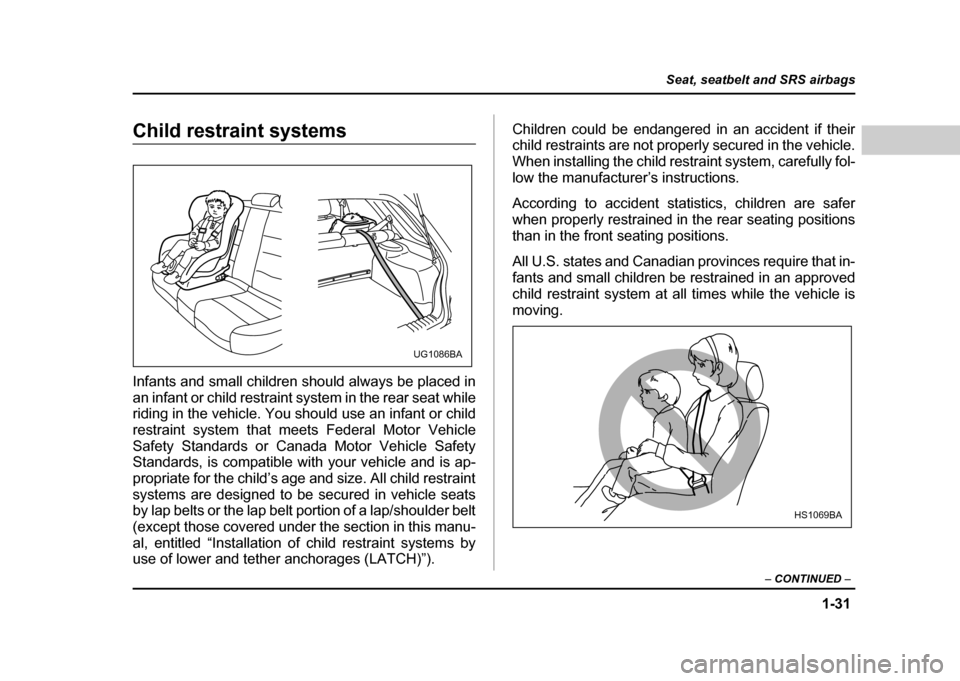
1-31
Seat, seatbelt and SRS airbags
– CONTINUED –
Child restraint systems
Infants and small children should always be placed in
an infant or child restraint system in the rear seat while
riding in the vehicle. You should use an infant or child
restraint system that meets Federal Motor Vehicle
Safety Standards or Canada Motor Vehicle Safety
Standards, is compatible with your vehicle and is ap-
propriate for the child’s age and size. All child restraint
systems are designed to be secured in vehicle seats
by lap belts or the lap belt portion of a lap/shoulder belt
(except those covered under the section in this manu-
al, entitled “Installation of child restraint systems by
use of lower and tether anchorages (LATCH)”). Children could be endangered in an accident if their
child restraints are not properly secured in the vehicle.
When installing the child restraint system, carefully fol-
low the manufacturer’s instructions.
According to accident statistics, children are safer
when properly restrained in the rear seating positions
than in the front seating positions.
All U.S. states and Canadian provinces require that in-
fants and small children be restrained in an approved
child restraint system at all times while the vehicle ismoving.
UG1086BA
HS1069BA
Page 59 of 491
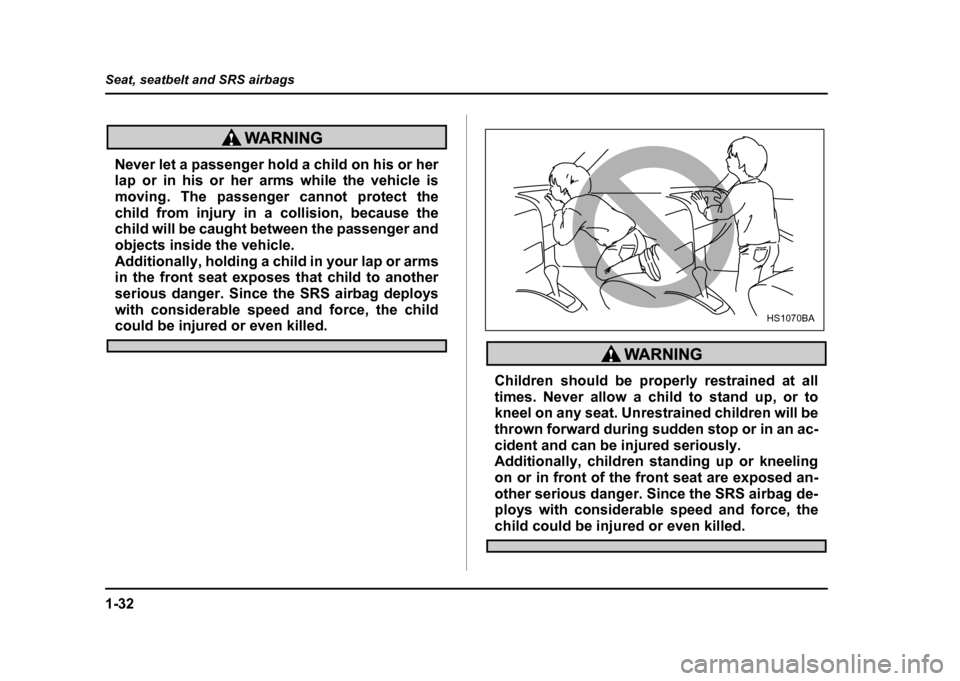
1-32
Seat, seatbelt and SRS airbags
Never let a passenger hold a child on his or her
lap or in his or her arms while the vehicle is
moving. The passenger cannot protect the
child from injury in a collision, because the
child will be caught between the passenger and
objects inside the vehicle.
Additionally, holding a child in your lap or arms
in the front seat exposes that child to another
serious danger. Since the SRS airbag deploys
with considerable speed and force, the child
could be injured or even killed.
Children should be properly restrained at all
times. Never allow a child to stand up, or to
kneel on any seat. Unrestrained children will be
thrown forward during sudden stop or in an ac-
cident and can be injured seriously.
Additionally, children standing up or kneeling
on or in front of the front seat are exposed an-
other serious danger. Since the SRS airbag de-
ploys with considerable speed and force, the
child could be injured or even killed.
HS1070BA
Page 60 of 491
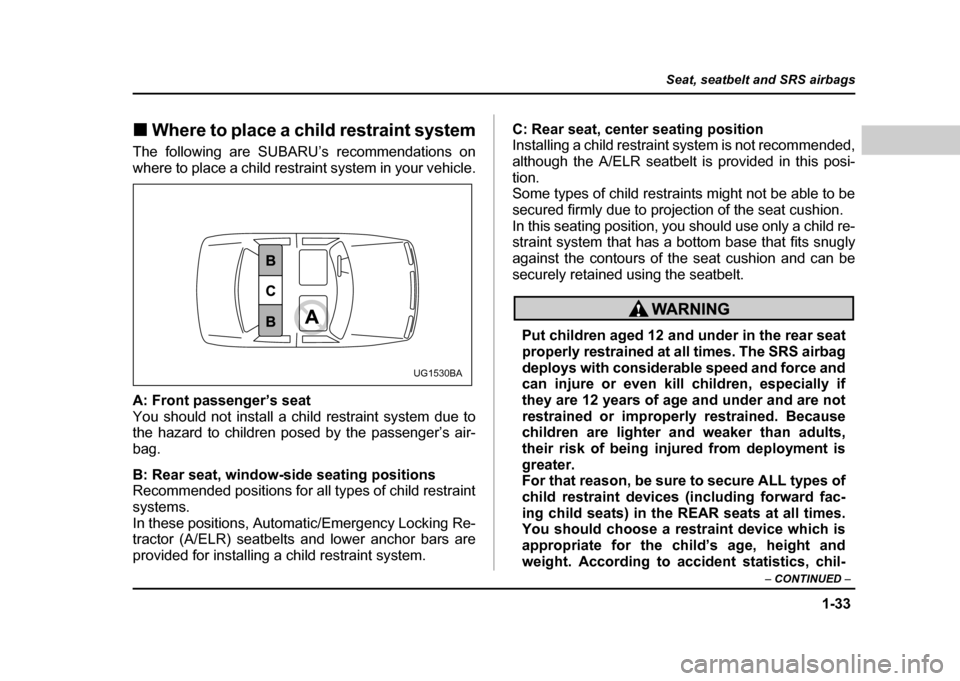
1-33
Seat, seatbelt and SRS airbags
– CONTINUED –
!Where to place a child restraint system
The following are SUBARU’s recommendations on
where to place a child restraint system in your vehicle.
A: Front passenger’s seat
You should not install a child restraint system due to
the hazard to children posed by the passenger’s air-
bag.
B: Rear seat, window-side seating positions
Recommended positions for all types of child restraint systems.
In these positions, Automatic/Emergency Locking Re-
tractor (A/ELR) seatbelts and lower anchor bars are
provided for installing a child restraint system. C: Rear seat, center seating position
Installing a child restraint system is not recommended,
although the A/ELR seatbelt is provided in this posi-
tion.
Some types of child restraints might not be able to be
secured firmly due to projection of the seat cushion.
In this seating position, you should use only a child re-
straint system that has a bottom base that fits snugly
against the contours of the seat cushion and can be
securely retained using the seatbelt.
Put children aged 12 and under in the rear seat
properly restrained at all times. The SRS airbag
deploys with considerable speed and force and
can injure or even kill children, especially if
they are 12 years of age and under and are not
restrained or improperly restrained. Because
children are lighter and weaker than adults,
their risk of being injured from deployment is
greater.
For that reason, be sure to secure ALL types of
child restraint devices (including forward fac-
ing child seats) in the REAR seats at all times.
You should choose a restraint device which is
appropriate for the child’s age, height and
weight. According to accident statistics, chil-
UG1530BA